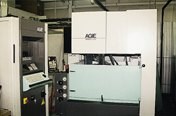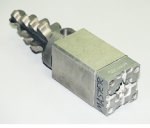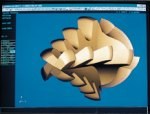How This Cutter Came To Be
The capabilities of wire EDM helped make an unusual milling cutter more efficient.
Share





Hwacheon Machinery America, Inc.
Featured Content
View More


Autodesk, Inc.
Featured Content
View More.png;maxWidth=45)
DMG MORI - Cincinnati
Featured Content
View More
The staff at Advanced Machining Corporation (Salisbury, North Carolina) was proficient at using EDM (electrical discharge machining), both wire and ram, in their tool and die shop. The two founding partners, Keith Felts and Bobby Miller, had been application engineers for an EDM builder, so they understood the flexibility and versatility of the EDM process. Having their own shop gave them the opportunity to apply that knowledge to solve difficult tooling problems for customers.
In fact, it was their excellent track record at this kind of work that encouraged Jim Cox, a manufacturing engineer-specialist at Westinghouse Electric in Winston-Salem, North Carolina, to come to them with a cutting tool challenge. Jim Cox believed that wire EDM could help improve the design of a special milling cutter used to mill the "Christmas tree" root forms in turbine blade hubs. These cutters were used by a unit of Westinghouse in nearby Charlotte, which manufactures turbines for the energy industry. One of these milling cutters is shown in Figure 1.
Advanced Machining took on the project, even though the company did not have much experience with cutting tools. This project would compel the partners to become experts in the production of special cutters. This meant applying what they knew about EDM to what they had to learn about the dynamics of cutting tool performance.
The redesigned cutters that Advanced Machining now produces offer significantly better performance than the previous design. The cutters are removing metal faster, lasting longer between regrinds, and getting additional regrinds in the life of the tool. More important, the cutters are being manufactured to tolerances so tight that the customer is confident that the slots milled with them are within specifications. That's a big plus because there is no economical way to measure these slots directly. Lead time to acquire these cutters also dropped from 16-18 weeks to a matter of days, or even hours.
Advanced Machining continues to test designs of new sizes and styles of these cutters. "Our experience with these cutters says a lot about the capabilities of wire and ram EDM—especially wire. And there are some valuable lessons about milling cutters to be learned as well," comments Mr. Felts.
Experience Counts
Bobby Miller and Keith Felts had a key advantage when they opened their shop in 1986. Both started careers as applications engineers for Elox Corporation, an EDM builder in nearby Davidson, North Carolina, and were with the company when it became part of the AGIE organization. They had helped
numerous customers solve problems with EDM. This experience taught them to be creative and imaginative with the process. They were in a situation to learn from the creativity and imagination of the customers they worked with, too.
Their first machine was a wire EDM. They knew that the earning potential of even a single wire machine could sustain their shop from the beginning as their customer base grew. They added a second wire machine in the second year and a manual ram EDM in the third year. According to Mr. Felts, the ability to run a wire machine over unattended shifts and weekends makes the wirecut process "a real moneymaker."
Today the shop is a well-rounded tool and die house that can take responsibility for an entire job, not just the EDM portion—although EDM still represents the core of its capability. In fact, the seven-employee shop is gradually moving into short-run production jobs and prototyping.
The shop's two vertical machining centers are routinely operated overnight in the unattended mode, as are the ram EDMs. "Running unattended is a way of life around here," says Mr. Felts. "It's really the only way to run a shop of this size profitably."
The company's business is an interesting mix of job shop and production work. In fact, some of its work is a hybrid of the two as well. For example, the shop produces small carbide dies for a major producer of molded plastic electrical connectors. The material used in these tools is a tough, highly abrasive engineering plastic that wears out tooling quickly. The manufacturer consumes a large number of these dies because of the high volume of molded connectors produced each month. Advanced Machining now produces these dies almost on a production basis, with workpieces ganged in fixtures and certain operations automated for high efficiency.
Other jobs are high-precision tooling and close-tolerance prototype work, generally of the challenging nature. This kind of work keeps interest high and skills honed.
When Advanced Machine started working with Westinghouse, it was the shop's ability to handle complicated, close tolerance gage work that was the main attraction. It also established the shop's reputation as a problem solver. That is why Jim Cox at Westinghouse turned to it for the milling cutter job.
He saw the potential for using wire EDM to cut the edges of the cutter. Two years ago, he approached Advanced Machining with an offer to work with him on a redesign of these cutters and to take advantage of the wire cut process.
Getting Some Relief
Turbine blades operate under harsh conditions. Rotational speeds are often high. Operating pressures and temperatures also can be intense. Each blade is fitted to the hub by means of a shaped root section that fits into a matching slot on the hub. Because these root sections are tapered and lobed, they resemble Christmas trees, hence the nickname.
Machining these slots requires special milling cutters with profiles that match the shape of the Christmas tree. The cutters are produced in several sizes between 5 and 8 inches long, not counting the tapered shank. In the past, the profile of each cutter was produced on a grinder by another shop. Grinding had several drawbacks.
The major problem with the ground cutters was a lack of relief on the sides of the cutter teeth. With no relief on these edges, they necessarily rubbed the workpiece during the cut, causing premature tool wear and limiting speeds and feeds.
Grinding also tended to produce inconsistent results from the first tool in the batch to the last, due to wearing of the grinding wheel. Although all of the ground tools in a batch might meet tolerances, those at the small end of the tolerance band could be reground fewer times that those at the high end because sufficient stock for regrinding would not be available.
EDM To The Rescue
The team at Advanced Machining welcomed the challenge. It was a more complex problem than might be expected at first glance. The tapered Christmas tree shape of the cutter is one of the difficulties that complicated the project. Because the lobes were different diameters, each lobe cut best at a different set of feeds and speeds. Parameters that work best at one part of the tool were likely to be too slow or too fast for other parts.
Essentially, the shop manipulated the cutter geometry in CAD/CAM and altered the relief angle to find the design that provided the best cutting action. This process is ongoing, as the shop continues to review and test different ideas. For example, the staff is studying how to create positive relief on the inside of the cutter face to act as a kind of chipbreaker geometry. Another promising development is a helical flute design, found to work very well on certain cutter styles.
Today, the cutters arrive as blanks that have been turned and gashed and heat-treated. The CAT 40 tapered shanks are also finish-ground when the tool blanks come in.
The blank tools are mounted in special stainless steel tooling blocks attached to System 3R Macro pallets, as shown in Figure 2. These stainless steel blocks feature tapered openings that are precision ground to match the taper of the toolholders. The blocks allow very precise and repeatable orientation of the cutter bodies. The cutting tools remain mounted in the tooling blocks until they are completed. All of the machines used to make the cutters are equipped with identical System 3R workholding fixtures so that the location and orientation of the cutters is maintained throughout the manufacturing process.
After mounting in the pallets, the cutters next go to one of the shop's ram EDM units. There, the relief angles will be created with graphite electrodes. The electrodes are also mounted in pallets identical to those used for the cutters. Figure 3 shows a typical electrode mounted on a fixture, with a cutter that has been ram EDMed.
Advanced Machining mills its own graphite electrodes on its two Haas VMCs. Both of these machines, one a VF-1 and the other a VF-3, are equipped with dust collection systems that the shop had installed to control graphite dust. The electrodes are double-sided to reduce graphite usage. (POCO EDM200 is the grade that is normally used for the electrodes.)
Because the electrodes are mounted on precision holders, they can be indexed and used for both rough and finish burns.
The shop has three CNC ram EDMs: one ELOX machine and two AGIE units, an AGIETRON 200E and a MONDO Star 50. The cutters are ram EDMed on one or the other of the CNC machines. A cutter at this stage is shown in Figure 4, where you can see the relief roughed in. The flared edge assures that adequate stock, about 0.04 inch, remains for wire cutting.
The next step is wire cutting the actual cutting edges.
A Gage With Flutes
Advanced Machining has four wire machines: two AGIE 100 models, an AGIECUT 270, and an AGIECUT Classic, which is the newest wire EDM in the shop. Because the crux of the cutter production is in wire cutting the edges, having substantial wire capability is a must. High precision is likewise required. Tolerances on this step are tight—the finished contour of each cutter must be within ±0.0002 inch (0.0050 mm) of the specified geometry.
"The beauty of wire EDM is that it can cut with this kind of precision along the entire edge of the tool," says Mr. Felts. "There's no limit to the geometry it can reach. If we can program it, we can cut it."
Wire EDM is also highly repeatable. Each cutter has four flutes. After the edges on one flute are cut, the cutter is indexed in the precision holder, and the program is repeated to cut the next flute until the cutter is completed. Because the same wire path is repeated, the geometry will be virtually identical from cut to cut.
The ability of a wire machine to cut tapers is essential in this operation. Although tapers as extreme as 30 degrees are possible on many wire machines, this job requires a taper of about 10 degrees. The taper also must be conducted in four axes, that is, the upper and lower wire guides follow different paths to create the correct cutting angle along the edge of the flutes.
Submerged cutting is also critical. Three of the four wire machines at Advanced Machining allow submerged cutting, whereby the worktank can be filled with deionized water to cover the workpiece during wire cutting. Because the cutter is tapered, the upper and lower wire guides must stay far enough apart to create adequate clearance for the cutter at its widest diameter. Flushing action with only a stream of water from above and below would be inadequate for dependable wire cutting where the cutter has its smallest diameters.
The extreme accuracy achievable with wire EDM has several benefits. One is the ability to create cutters that, when finished, consistently start out at the upper tolerance limit. In other words, new cutters will be as large as allowed. This condition allows for wear and ensures that the sharp cutting edge will be retained even as the flute faces are reground, thus extending the cutter's useful life.
Another benefit is this. There is no effective and economical way to inspect the slots machined by these cutters. Thus, the quality of the slots is derived mainly by the quality of the cutters. The only way to verify the dimensions of the milled slot is by test-fitting a properly dimensioned turbine blade root.
"That's why we call these cutters `gages with flutes.'" Mr. Felts says. "The tolerances we achieve with these cutters are in the same range we achieve on the measurement gages we produce, and they are generally many times more accurate than the part of process they are used to verify."
Finished cutters are sent out to be glass-beaded and TiN-coated.
A Better Cutter
The Westinghouse plant that is supplied with these cutters is located nearby in Charlotte, North Carolina. The cutters are used to machine blade grooves in a 4350 alloy.
According to Larry Long, Principal Engineer at this plant, cutter performance has proven to be well worth the slightly higher cost of the redesigned cutters. Tool life is consistently higher because of the improved cutting action of the relieved edges. He also reports that the cutters generally get at least one extra regrind.
In practice, speeds and feeds are set at the point where the largest diameter of the cutter is just below the point that would cause the cutter to burn. This maximizes cutting speed at the portion of the cutter with the smallest diameter, keeping it above the point where the edges tend to chip.
Nevertheless, the dimensional consistency of the cutters appears to be the real payoff. Even if there was no improvement in tool life, the benefits to controlling the slot size would make the tools an attractive improvement.
Cutter design hasn't been the only element under review at this plant, where the search for quality and efficiency improvements is unceasing. According to Mr. Long, a synthetic cutting fluid developed by Wallover Oil Co. especially for this operation also has yielded significant improvement in cutter life.
Automation
The high level of automation at Advanced Machine may be its most surprising characteristic. "With only seven employees and about 15 major pieces of equipment, including ten CNC machine tools, we have to rely on unattended operation wherever possible," Mr. Felts points out.
Starting out with wire EDM turned out to be the ideal preparation for this scenario. "Managing a shop with one wire EDM teaches you how to get the most from flexible automation. Those lessons still apply, even though we keep moving into new areas and adding new machines," says Mr. Felts. "It's been a pattern for success."
Read Next
5 Rules of Thumb for Buying CNC Machine Tools
Use these tips to carefully plan your machine tool purchases and to avoid regretting your decision later.
Read MoreRegistration Now Open for the Precision Machining Technology Show (PMTS) 2025
The precision machining industry’s premier event returns to Cleveland, OH, April 1-3.
Read MoreBuilding Out a Foundation for Student Machinists
Autodesk and Haas have teamed up to produce an introductory course for students that covers the basics of CAD, CAM and CNC while providing them with a portfolio part.
Read More
























.png;maxWidth=150)

















.jpg;maxWidth=300;quality=90)











